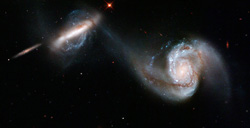Hubble sees the graceful dance of two interacting galaxies

Stars, gas, and dust flow from the large spiral galaxy, NGC 3808, forming an enveloping arm around its companion. The shapes of both galaxies have been distorted by their gravitational interaction. Arp 87 is located in the constellation of Leo, the Lion, approximately 300 million light-years away from Earth. Arp 87 appears in Arp’s Atlas of Peculiar Galaxies. As also seen in similar interacting galaxies, the corkscrew shape of the tidal material suggests that some stars and gas drawn from the larger galaxy have been caught in the gravitational pull of the smaller one. This image was taken in February 2007 with Hubble’s Wide Field Planetary Camera 2 detector.
Arp’s Atlas of Peculiar Galaxies is a compilation of astronomical photographs using the Palomar 200-inch Hale and the 48-inch Samuel Oschin telescopes.
The resolution in the Hubble image shows exquisite detail and fine structure that was not observable when Arp 87 was first discovered in the 1970’s.
The two main players comprising Arp 87 are NGC 3808 on the right (the larger of the two galaxies) and its companion NGC 3808A on the left. NGC 3808 is a nearly face-on spiral galaxy with a bright ring of star formation and several prominent dust arms. Stars, gas, and dust flow from NGC 3808, forming an enveloping arm around its companion. NGC 3808A is a spiral galaxy seen edge-on and is surrounded by a rotating ring that contains stars and interstellar gas clouds. The ring is situated perpendicular to the plane of the host galaxy disk and is called a “polar ring.”
As seen in other mergers similar to Arp 87, the corkscrew shape of the tidal material or bridge of shared matter between the two galaxies suggests that some stars and gas drawn from the larger galaxy have been caught in the gravitational pull of the smaller one.
The shapes of both galaxies have been distorted by their gravitational interaction with one another.
Interacting galaxies often exhibit high rates of star formation. Many lines of evidence – colours of their starlight, intensity of emission lines from interstellar gas, far-infrared output from heated interstellar dust – support this fact. Some merging galaxies have the highest levels of star formation we can find anywhere in the nearby Universe.
A major aspect of this excess star formation could be properly revealed only when Hubble turned its imaging capabilities toward colliding galaxies. Among the observatory’s first discoveries was that galaxies with very active star formation contain large numbers of super star clusters – clusters more compact and richer in young stars than astronomers were accustomed to seeing in our galactic neighbourhood.
Arp 87 is in the constellation Leo, the Lion, approximately 300 million light-years away from Earth. These observations were taken in February 2007 with the Wide Field Planetary Camera 2. Light from isolated blue, green, red, and infrared ranges was combined to form this colour image.
Media Contact
More Information:
http://www.spacetelescope.org/news/html/heic0717.htmlAll latest news from the category: Physics and Astronomy
This area deals with the fundamental laws and building blocks of nature and how they interact, the properties and the behavior of matter, and research into space and time and their structures.
innovations-report provides in-depth reports and articles on subjects such as astrophysics, laser technologies, nuclear, quantum, particle and solid-state physics, nanotechnologies, planetary research and findings (Mars, Venus) and developments related to the Hubble Telescope.
Newest articles

Peptides on Interstellar Ice
A research team led by Dr Serge Krasnokutski from the Astrophysics Laboratory at the Max Planck Institute for Astronomy at the University of Jena had already demonstrated that simple peptides…

A new look at the consequences of light pollution
GAME 2024 begins its experiments in eight countries. Can artificial light at night harm marine algae and impair their important functions for coastal ecosystems? This year’s project of the training…

Silicon Carbide Innovation Alliance to drive industrial-scale semiconductor work
Known for its ability to withstand extreme environments and high voltages, silicon carbide (SiC) is a semiconducting material made up of silicon and carbon atoms arranged into crystals that is…





















